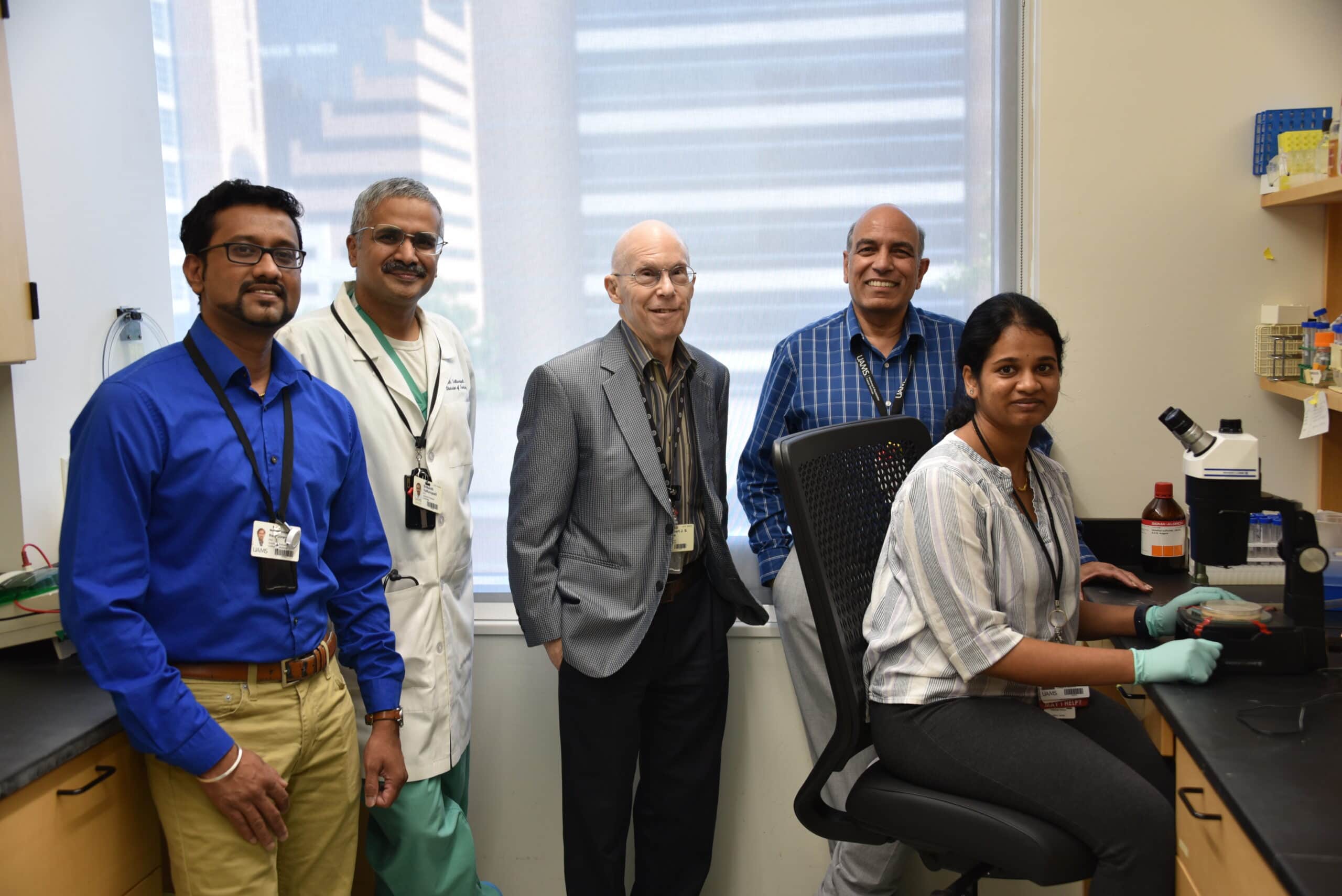UAMS Researchers Discover Cholesterol Drug’s Potential as Treatment for Alzheimer’s, Other Dementia
| Researchers from the University of Arkansas for Medical Sciences (UAMS) have discovered that an FDA-approved cholesterol drug holds the potential to disrupt the progression of Alzheimer’s disease and other forms of dementia.
The research team published its findings in the journal Aging Biology. Akshatha Ganne, a postdoctoral fellow in the UAMS College of Medicine’s Department of Geriatrics, is the lead author. Srinivas Ayyadevara, Ph.D., associate professor in the College of Medicine, and Robert J. Shmookler Reis, Ph.D., professor in the College of Medicine, are the corresponding/senior authors of the paper.
Approved by the U.S. Food and Drug Administration (FDA) in 2002, ezetimibe is a prescription medication that reduces the amount of cholesterol absorbed by the intestines.
“It has an excellent safety record, with few side effects, but has been largely superseded by statins, which are somewhat more effective at lowering cholesterol,” said co-author and cardiologist Srikanth Vallurupalli, M.D.
The team’s research focused on aggregates made up of tangled proteins, commonly seen in the brains of Alzheimer’s patients. Scientists consider these and similar accumulations to be key factors in the progression of most or all cognitive disorders, Reis said.
He added, “We found that they also occur in brains of those with heart disease, which is known to increase the subsequent risk of Alzheimer’s disease.”
The researchers used 3D-analysis tools to map the sticky sites within typical aggregates and to discover which ones are most important for holding these clumps together. This computer analysis was conducted by Meenakshisundaram Balasubramaniam, Ph.D., assistant professor in the Department of Geriatrics, who then simulated interactions with more than 1,800 FDA-approved medications, to seek molecules that best disrupt the aggregation process. That search led them to ezetimibe, which was then shown to prevent specific aggregate proteins from sticking to one another in lab-grown neurons.
“When you block certain disease-associated protein interactions, they lose the ability to clump together in a way that leads to cognitive decline,” said Ayyadevara. “We focused on ezetimibe and found that it prevented a key aggregate interaction found only in the brains of people with Alzheimer’s and in lab models of Alzheimer’s-like aggregation.”
To assess the drug’s real-world effect, the team explored a clinical database to analyze data on approximately 950,000 older adults — 4,361 of whom were receiving ezetimibe to lower cholesterol levels. The data revealed that patients taking ezetimibe had a much lower incidence of Alzheimer’s and related forms of dementia than those in the control group, according to Joseph Asante, Ph.D., one of the study co-authors.
“Joseph’s analysis indicated a nearly eightfold reduction in relative risk for patients taking ezetimibe, which is by far the highest and most significant protective efficacy anyone has ever observed for a drug intervention to prevent Alzheimer’s,” Reis said.
Corey Nagel, Ph.D., RN, associate professor in the UAMS College of Nursing, was also a collaborator in the study.
Ayyadevara said the researchers’ next step is to set up controlled studies of ezetimibe’s ability to protect two high-risk groups from dementia: heart-disease patients and people with mild cognitive impairment. Such studies are the accepted way to establish whether the drug — and not some other factor — is able to slow or prevent cognitive decline.
“We hope that this may ultimately provide an intervention for people with an increased likelihood of developing Alzheimer’s due to one or more of the known risk factors,” Reis said. “Those include mild cognitive impairment, which can be a precursor to Alzheimer’s, and other predisposing conditions such as heart disease, diabetes, or genetic variants that are linked to familial Alzheimer’s.
“Additional studies will be needed to confirm its effectiveness and safety for those at-risk groups,” he added. “However, the current UAMS study offers compelling evidence of ezetimibe’s potential to protect those at highest risk of developing Alzheimer’s disease and related dementias.”
Jeanne Wei, M.D., Ph.D., executive director of the UAMS Donald W. Reynolds Institute on Aging, said she looks forward to seeing the next steps in the team’s research.
“These findings will have important implications for the prevention of Alzheimer’s disease and dementia,” she said.
UAMS is the state’s only health sciences university, with colleges of Medicine, Nursing, Pharmacy, Health Professions and Public Health; a graduate school; a hospital; a main campus in Little Rock; a Northwest Arkansas regional campus in Fayetteville; a statewide network of regional campuses; and eight institutes: the Winthrop P. Rockefeller Cancer Institute, Jackson T. Stephens Spine & Neurosciences Institute, Harvey & Bernice Jones Eye Institute, Psychiatric Research Institute, Donald W. Reynolds Institute on Aging, Translational Research Institute, Institute for Digital Health & Innovation and the Institute for Community Health Innovation. UAMS includes UAMS Health, a statewide health system that encompasses all of UAMS’ clinical enterprise. UAMS is the only adult Level 1 trauma center in the state. UAMS has 3,485 students, 915 medical residents and fellows, and seven dental residents. It is the state’s largest public employer with more than 11,000 employees, including 1,200 physicians who provide care to patients at UAMS, its regional campuses, Arkansas Children’s, the VA Medical Center and Baptist Health. Visit www.uams.edu or uamshealth.com. Find us on Facebook, X (formerly Twitter), YouTube or Instagram.###
